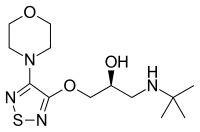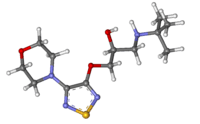Timolol
Timolol is a medication used either by mouth or as eye drops.[2][3] As eye drops it is used to treat increased pressure inside the eye such as in ocular hypertension and glaucoma.[2] By mouth it is used for high blood pressure, chest pain due to insufficient blood flow to the heart, to prevent further complications after a heart attack, and to prevent migraines.[3]
 | |
 | |
| Clinical data | |
|---|---|
| Trade names | Betimol, Istalol, others[1] |
| AHFS/Drugs.com | Monograph |
| MedlinePlus | a684029 |
| License data | |
| Pregnancy category | |
| Routes of administration | By mouth, topical (eye drop) |
| Drug class | Beta blocker |
| ATC code | |
| Legal status | |
| Legal status | |
| Pharmacokinetic data | |
| Bioavailability | 60% |
| Metabolism | Liver (80%) |
| Elimination half-life | 2.5–5 hours |
| Excretion | Kidney |
| Identifiers | |
| |
| CAS Number | |
| PubChem CID | |
| IUPHAR/BPS | |
| DrugBank | |
| ChemSpider | |
| UNII | |
| KEGG | |
| ChEBI | |
| ChEMBL | |
| CompTox Dashboard (EPA) | |
| ECHA InfoCard | 100.043.651 |
| Chemical and physical data | |
| Formula | C13H24N4O3S |
| Molar mass | 316.42 g·mol−1 |
| 3D model (JSmol) | |
| |
| |
| (verify) | |
Common side effects with the drops is irritation of the eye.[2] Common side effects by mouth include tiredness, slow heart beat, itchiness, and shortness of breath.[3] Other side effects include masking the symptoms of low blood sugar in those with diabetes.[2] Use is not recommended in those with asthma, uncompensated heart failure, or COPD.[2] It is unclear if use during pregnancy is safe for the baby.[4] Timolol is a non-selective beta blocker.[2]
Timolol was patented in 1968, and came into medical use in 1978.[5] It is on the World Health Organization's List of Essential Medicines.[6] Timolol is available as a generic medication.[2] In 2017, it was the 146th most commonly prescribed medication in the United States, with more than four million prescriptions.[7][8]
Medical uses
By mouth
In its by mouth form, it is used:
- to treat high blood pressure
- to prevent heart attacks
- to prevent migraine headaches[9]
Eye drops
In its eye drop form it is used to treat open-angle and, occasionally, secondary glaucoma.[2][10] The mechanism of action of timolol is probably the reduction of the formation of aqueous humor[2] in the ciliary body in the eye. It was the first beta blocker approved for topical use in treatment of glaucoma in the United States (1978).[11] When used by itself, it depresses intraocular pressure (IOP) 18–34% below baseline within first few treatments. However, there are short-term escape and long-term drift effects in some people. That is, tolerance develops. It may reduce the extent of diurnal IOP curve up to 50%. IOP higher during sleep. Efficacy of timolol in lowering IOP during the sleep period may be limited.[12][13][14] It is 5–10× more potent β blocker than propranolol. Timolol is light-sensitive; it is usually preserved with 0.01% benzalkonium chloride (BAC), but also comes BAC-free. Can also be used in adjunctive therapy with pilocarpine or carbonic anhydrase inhibitors.[15]
A Cochrane review compared the effect of timolol versus brimonidine in slowing the progression of open angle glaucoma in adults but found insufficient evidence to come to conclusions.[16]
On the skin
In its gel form it is used on the skin to treat infantile hemangiomas.[17]
Contraindications
The medication should not be taken by individuals with:[18]
- An allergy to timolol or any other beta-blockers
- Asthma or severe chronic obstructive bronchitis
- A slow heart rate (bradycardia), or a heart block
- Heart failure[19]
Side effects
The most serious possible side effects include cardiac arrhythmias and severe bronchospasms.[18] Timolol can also lead to fainting, congestive heart failure, depression, confusion, worsening of Raynaud's syndrome and impotence.[18]
Side effects when given in the eye include: burning sensation, eye redness, superficial punctate keratopathy, corneal numbness.[20][10]
Formulations
It is available in tablet and liquid formulations.[18][20]
For ophthalmic use, timolol is also available combined:
- with carbonic anhydrase inhibitors:
- timolol and brinzolamide
- timolol and dorzolamide
- with α2 agonists:
- with prostaglandin analogs:
- timolol and latanoprost
- timolol and travoprost
Brand names
Timolol is marketed under many trade names worldwide.[1] Timolol eye drops are marketed under the brand name Istalol among others.[21][22]
References
- "Timolol". Drugs.com. Archived from the original on 7 March 2016. Retrieved 28 December 2016.
- "Timolol eent". The American Society of Health-System Pharmacists. Archived from the original on 28 December 2016. Retrieved 8 December 2016.
- "Timolol Maleate". The American Society of Health-System Pharmacists. Archived from the original on 28 December 2016. Retrieved 8 December 2016.
- "Timolol ophthalmic Use During Pregnancy". The American Society of Health-System Pharmacists. Archived from the original on 28 December 2016. Retrieved 28 December 2016.
- Fischer J, Ganellin CR (2006). Analogue-based Drug Discovery. John Wiley & Sons. p. 460. ISBN 9783527607495. Archived from the original on 28 December 2016.
- World Health Organization (2019). World Health Organization model list of essential medicines: 21st list 2019. Geneva: World Health Organization. hdl:10665/325771. WHO/MVP/EMP/IAU/2019.06. License: CC BY-NC-SA 3.0 IGO.
- "The Top 300 of 2020". ClinCalc. Retrieved 11 April 2020.
- "Timolol - Drug Usage Statistics". ClinCalc. Retrieved 11 April 2020.
- Marcus DA, Bain PA (27 February 2009). Effective Migraine Treatment in Pregnant and Lactating Women: A Practical Guide. シュプリンガー・ジャパン株式会社. pp. 141–. ISBN 978-1-60327-438-8. Archived from the original on 5 November 2017. Retrieved 14 November 2010.
- "Timolol Ophthalmic". MedlinePlus. 15 April 2017. Retrieved 31 December 2019.
- Sambhara D, Aref AA (January 2014). "Glaucoma management: relative value and place in therapy of available drug treatments". Therapeutic Advances in Chronic Disease. 5 (1): 30–43. doi:10.1177/2040622313511286. PMC 3871276. PMID 24381726.
- Liu JH, Kripke DF, Weinreb RN (September 2004). "Comparison of the nocturnal effects of once-daily timolol and latanoprost on intraocular pressure". American Journal of Ophthalmology. 138 (3): 389–95. doi:10.1016/j.ajo.2004.04.022. PMID 15364220.
- Liu JH, Medeiros FA, Slight JR, Weinreb RN (March 2009). "Comparing diurnal and nocturnal effects of brinzolamide and timolol on intraocular pressure in patients receiving latanoprost monotherapy". Ophthalmology. 116 (3): 449–54. doi:10.1016/j.ophtha.2008.09.054. PMID 19157559.
- Liu JH, Slight JR, Vittitow JL, Scassellati Sforzolini B, Weinreb RN (September 2016). "Efficacy of Latanoprostene Bunod 0.024% Compared With Timolol 0.5% in Lowering Intraocular Pressure Over 24 Hours". American Journal of Ophthalmology. 169: 249–257. doi:10.1016/j.ajo.2016.04.019. PMID 27457257.
- Strohmaier K, Snyder E, Adamsons I (July 1998). "A multicenter study comparing dorzolamide and pilocarpine as adjunctive therapy to timolol: patient preference and impact on daily life". Journal of the American Optometric Association. 69 (7): 441–51. PMID 9697378.
- Sena DF, Lindsley K (January 2017). "Neuroprotection for treatment of glaucoma in adults". The Cochrane Database of Systematic Reviews. 1 (1): CD006539. doi:10.1002/14651858.CD006539.pub4. PMC 5370094. PMID 28122126.
- Novoa M, Baselga E, Beltran S, Giraldo L, Shahbaz A, Pardo-Hernandez H, Arevalo-Rodriguez I (April 2018). "Interventions for infantile haemangiomas of the skin". The Cochrane Database of Systematic Reviews. 4: CD006545. doi:10.1002/14651858.CD006545.pub3. PMC 6513200. PMID 29667726.
- "Timolol Maleate tablet". DailyMed. 17 August 2006. Retrieved 1 December 2019.
- "Package leaflet: Information for the user Timolol" (PDF). hpra.ie.
- "Betimol- timolol solution". DailyMed. 18 March 2010. Retrieved 1 December 2019.
- "Generic Istalol Availability". Drugs.com. Retrieved 20 June 2019.
- "Istalol". Drugs.com. 1 August 2018. Retrieved 19 July 2019.
External links
- "Timolol". Drug Information Portal. U.S. National Library of Medicine.
- "Timolol Ophthalmic". Drug Information Portal. U.S. National Library of Medicine.